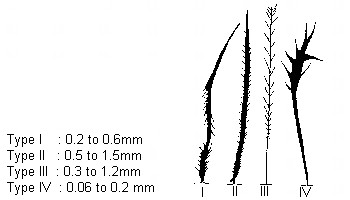Urticating Hairs Jean Michel Verdez (France) |
| A great number of tarantulas (from north
U.S.A. through latin America) have on the opisthosoma
thousands of urticating hairs. These hairs are a way of
effective defence (in addition to the venom) against
attackers. These hairs come off very easily from the
opisthosoma (they are situated at the top of the
opisthosoma) by a simple rub of one or more legs. There
are several types of urticating hairs (see diagram) and
these are also of different sizes. These hairs are
respectively:-
Only Ischnocolinae, Aviculariinae and Theraphoseae have urticating hairs. Hairs of type II are typical of Aviculariinae. Hairs of type IV are typical of Grammostola. We can see from the diagram that the shape of urticating hairs and barbs are different. Urticating hairs do not appear completely on the opisthosoma at birth. They form a dark mark, and this stretches progressively after each moult (for example, Lasiodora anax, Brachypelma albopilosa and Aphonopelma hentzi). We must not confuse urticating hairs with abdominal hairs. Urticating hairs do not cover the entire opisthosoma. The function of abdominal hairs is unknown. Tarantulas also use urticating hairs to establish their territories, and also for making the cocoon. It is possible that this last use is a way of protecting the cocoon. The urticating hairs are a formidable weapon against an intruder, but according to the species and where the hairs are introduced the effects will be different; sometimes trifling, sometimes important and even dangerous. According to Vellard (1936) and Bucherl (1951), the genera with the most urticating hairs are Lasiodora, Grammostola and Acanthoscurria. Except for Grammostola, the other genera have hairs of type III, and we can also add Brachypelma smithii. There are a number of other species notable for their urticating hair, for example, Theraphosa le-blondi, Pamphobeteus antinous and P. platyomma and It would be interesting to know what type of hairs these species have. Among Avicularia, they very rarely throw hairs, except sometimes Avicularia versicolor notably when she has a cocoon or just in post-moult. On the other hand, Avicularia metallica cover their lair with urticating hairs, and when you put your hand in you end up with it full of these hairs. According to Cooke, Roth and Miller (1972), urticaria causes a feeling of prickling with Avicularia surinamensis. Prickling is the real word in my opinion with, in addition to that, pimples and itching (A. metallica). Among tarantulas without urticating hairs, aggression is shown by exhibiting the fangs, and this can go on to an attack (Stromatopelma griseipes, Citharischius crawshayi, Pterinochilus murinus and Ornithoctonus andersoni. This is an attitude shown to a lesser extent by New World tarantulas. These tarantulas have a defensive attitude (for example Brachypelma smithii, Lasiodora parahybana and Brachypelma emelia throwing urticating hairs) but others attack directly, for example Theraphosa leblondi, Xeneathis monstrosaa and Pamphobeteus platyomma. I would like to know if tarantulas without urticating hairs are more aggressive than tarantulas with urticating hair. I would like to know if the venom of tarantulas without urticating hair is more potent than the venom of tarantulas with urticating hairs. Now, here are some species with my reaction to their urticating hairs along with observations:- Brachypelma smithii (Cambridge 1897): Itching with a burning sensation. Itching blur rapidly at the end of 30 minutes, but they reappear until 24 hours after and several times day and night Brachypelma vagans (Ausserer 1875): Slight itching which blur rapidly in 30 minutes. This returns in the day, but it is not systematic. Brachypelma albopilosa (Valerio 1980): This species does not throw urticating hairs and the effects are insignificant. Brachypelma albopilosa (White 1856): This species throws often and with large amounts of urticating hairs. Slight itching (more than B. vagms) which comes back several times by day but they blur rapidly in 15 minutes. Grammostola pulchra (Mello-Leitao 1921): This species does not often throw urticating hairs Grammostola spatulata (Cambridge 1897): As for G. pulchra. Metrioplema zebratus (Banks 1903): Slight itching which blur rapidly in 15 minutes. On the other hand, my wife is very allergic (intense itching day and night). This species must have a restricted area of urticating hairs. Pterinopelma saltator (Pocock 1903): As for G. pulchra. Aphonopelma chalcodes (Chamberlin 1939): Slight .d brief itching (15 minutes). Lasiodora parahybana (Mello-Leitao 1917): Very important itching which lasts about 30 minutes and which comes back during the day. Pamphobeteus platyomma (Mello-Leitao 1923): Same effects as L.parahybana but less intense. Pamphobeteus antinous (Pocock 1903): Very intense itching for one hour which returns day and night. In addition to that I experienced the feeling of something in my throat (inhalation of hairs) causing me to cough. Xenesthis monstrosa (Pocock 1903): This species does not throw urticating hairs much. Therahosa lebloncli (Latreille 1804): As for P. antinous. Avicularia avicularia (Lime 1758): This species gives me a very interesting reaction. When I remove moults I have a terrible itching of pimples. These eruptions are brief, and last only about 30 minutes, but the itching comes back several times during the day. This phenomenon happens only when I remove moults. Of course, these effects are only persona any other observations or corrections let me know. Bibliography Cooke,,J.A.L., Roth V.D. and Miller F.R.: "The urticating hairs of theraphosid spiders : Mus. Am. Nat. Hist., New York, 21/6/72. I would also like to thank Patrick Marechal (Mus. Fr. Hist. Nat., Paris) for providing me with this paper. |
